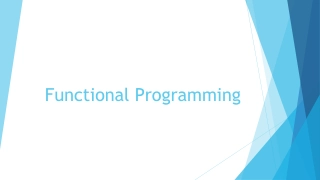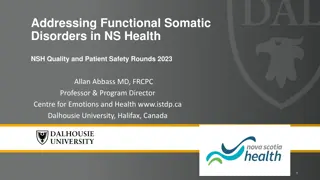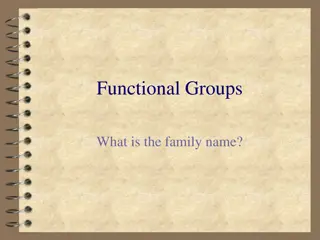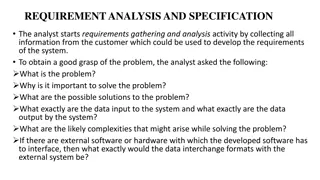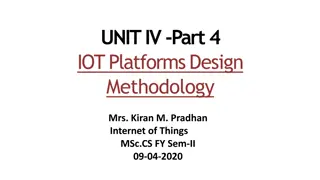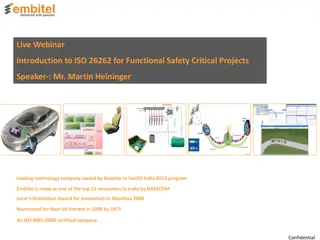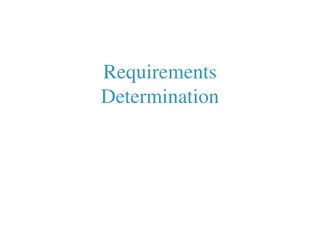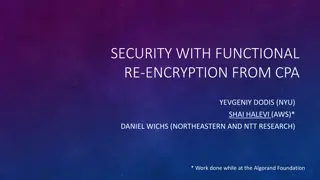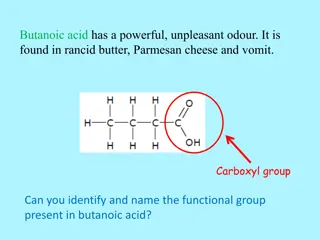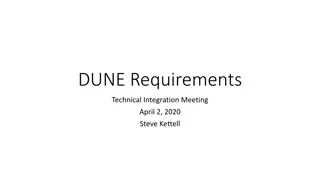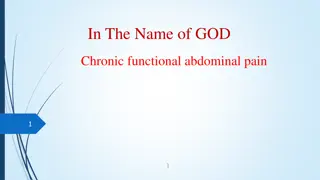
IEEE 802.11 EHT Specification Framework Functional Requirements
This document outlines the functional requirements proposed for the IEEE 802.11 EHT specification framework, focusing on multi-band/multi-channel operation, backward compatibility, and supporting real-time applications over WLAN. It highlights the maximum throughput, carrier frequency, compatibility with legacy devices, and objectives of throughput enhancement, reliability, latency reduction, power efficiency, and performance improvement.
Download Presentation

Please find below an Image/Link to download the presentation.
The content on the website is provided AS IS for your information and personal use only. It may not be sold, licensed, or shared on other websites without obtaining consent from the author. If you encounter any issues during the download, it is possible that the publisher has removed the file from their server.
You are allowed to download the files provided on this website for personal or commercial use, subject to the condition that they are used lawfully. All files are the property of their respective owners.
The content on the website is provided AS IS for your information and personal use only. It may not be sold, licensed, or shared on other websites without obtaining consent from the author.
E N D
Presentation Transcript
2019 doc.: IEEE 802.11-2019/0105r1 Functional Requirements for EHT Specification Framework Date: 2019-01-14 Authors: Name Affiliation Address Phone Email Yonggang Fang ZTE (TX) yfang@ztetx.com Bo Sun ZTE Kaiying Lv ZTE Nan Li ZTE Zhiqiang Han ZTE Submission 1 Yonggang Fang, etc, ZTE
2019 doc.: IEEE 802.11-2019/0105r1 Abstract The IEEE802.11 specification framework document is used to provide an outline of functional blocks to be developed in an amendment of the specification, and reflect the working group consensus on new features and their definitions. This contribution proposes the high level functional requirements of potential features for IEEE 802.11 EHT specification framework. Submission 2 Yonggang Fang, etc, ZTE
2019 doc.: IEEE 802.11-2019/0105r1 Background EHT PAR and CSD [1][2] EHT enable modes of operation capable of supporting a maximum throughput of at least 18/30 Gbps Operating on carrier frequency between 1 and 7.125 GHz Ensuring backward compatibility and coexistence with legacy IEEE802.11 devices in the 2.4 and 5 GHz unlicensed bands, and with IEEE802.11ax devices in the 6 GHz band EHT focuses on indoor and outdoor operation in the 2.4 GHz, 5 GHz and 6GHz frequency bands. 320MHz bandwidth and more efficient utilization of non-contiguous spectrum, Multi-band/multi-channel aggregation and operation, 16 spatial streams and MIMO protocols enhancements, Multi-AP Coordination (e.g. coordinated and joint transmission), Enhanced link adaptation and retransmission protocol (e.g. HARQ), If needed, adaptation to regulatory rules specific to 6 GHz spectrum, Refinements of 802.11ax features. Submission 3 Yonggang Fang, etc, ZTE
2019 doc.: IEEE 802.11-2019/0105r1 Background Objectives EHT is to support various real-time applications over WLAN with Throughput enhancement, Reliability enhancement, Latency and jitter reduction, Power efficiency and performance improvement This contribution will propose some functional requirements for the SFD Multi-band/multi-channel operation Multi-AP operation Enhanced link adaptation and retransmission Submission 4 Yonggang Fang, etc, ZTE
2019 doc.: IEEE 802.11-2019/0105r1 Functional Requirements Multi-Band/Multi-Channel Operation Multi-band operation can provide an EHT station with one or more wide bandwidth channels over different bands to support extreme high throughout. [REQ-MB-1] EHT should support the multi-band operation in 2.4 GHz, 5 GHz and/or 6 GHz band simultaneously or individually [1][2]. [REQ-MB-1.1] EHT AP shall support the multi-band operation. [REQ-MB-1.2] EHT non-AP station may support the multi-band operation optionally. [REQ-MB-2] EHT shall be backward compatible to existing 802.11 [1][2]. [REQ-MB-2.1] In 2.4 GHz and 5 GHz band, EHT shall be backward compatible to legacy 802.11, i.e. 802.11ax, 802.11ac, 802.11n, etc. [REQ-MB-2.2] In 6 GHz band, EHT shall be backward compatible to 802.11ax. Submission 5 Yonggang Fang, etc, ZTE
2019 doc.: IEEE 802.11-2019/0105r1 Functional Requirements Multi-Band/Multi-Channel Operation 6 GHz band is the shared access spectrum with other wireless communication services, such as fixed access or satellite service. Those are the primary services in this band. EHT stations shall follow the regulation of individual country to operate in 6 GHz band. [REQ-MB-3] An EHT as the secondary wireless access service shall support the shared access with the primary wireless communication services in 6 GHz via dynamic or semi-dynamic spectrum management [3]. In the 5.925-6.425 GHz and 6.525-6.875 GHz sub-bands, an EHT STA would only be allowed to transmit under the control of an automated frequency control (AFC) system. In the 6.425-6.525 GHz and 6.875-7.125 GHz sub-bands, an EHT STA would be restricted to indoor use and would operate at lower power, without an AFC system Submission 6 Yonggang Fang, etc, ZTE
2019 doc.: IEEE 802.11-2019/0105r1 Functional Requirements Multi-Band/Multi-Channel Operation (cont) Channel discovery is important in the multi-band/multi-channel operation. As 6 GHz band is a green field, it is possible to reduce the time of channel discovery, which should be an requirement for 6 GHz band operation. [REQ-MB-4] EHT should support the fast channel discovery mechanism for 6 GHz band [4] [REQ-MB-4.1] EHT should support the discovery of channel in 6GHz through the channel information report in 2.4 GHz, 5 GHz, and/or 6 GHz band. IEEE802.11 supports contention based channel access. In 802.11ax, a trigger based channel access is used for multiple stations to access to the medium. However the trigger based channel access still faces the efficiency issue and longer access delay due to collision for many stations access to the medium at same time. [REQ-MB-5] EHT should support fast channel access mechanism to reduce the access collision and improve the access efficiency [4]. [REQ-MB-5.1] An EHT station may not support EDCA mechanism in 6GHz band. Submission 7 Yonggang Fang, etc, ZTE
2019 doc.: IEEE 802.11-2019/0105r1 Functional Requirements Multi-Band/Multi-Channel Operation (cont) When an EHT station operating in multi-channel (in multi-band), its transmissions over those channels could be independent or synchronized. Channel aggregation could be required for improving the transmission throughput. [REQ-MB-6] EHT should support two transmission modes in Multi-Band operation [9]. [REQ-MB-6.1] EHT should support synchronized transmissions in Multi-Band operation in which the transmissions over multiple channels of Multi-Band are aligned up. [REQ-MB-6.2] EHT should support asynchronous transmissions in Multi-Band operation which the transmissions over multiple channels of Multi-Band are independently. [REQ-MB-7] EHT should support the channel aggregation over multi-channel in Multi-Band operation [1][2][9]. Submission 8 Yonggang Fang, etc, ZTE
2019 doc.: IEEE 802.11-2019/0105r1 Functional Requirements Multi-AP Operation Multi-AP has been specified in WFA, and is being enhanced now. It can be used to improve the radio coverage via multi AP mesh or relay networking in the home or enterprise environment. [REQ-MAP-1] EHT should support Multi-AP operation to improve the transmission reliability and throughput [4][6]. [REQ-MAP-2] EHT should support Multi-AP operation to reduce the interference [4][6]. [REQ-MAP-3] EHT should support Multi-AP operation via multi-channels to improve the transmission reliability [4]. [REQ-MAP-4] EHT should support Multi-AP coordination in the following ways [5] a) Transmitting on the same frequency resource: coordinating and forming spatial nulls to allow for simultaneous transmissions from multiple APs, or b) Transmitting on orthogonal frequency resources: coordinating and splitting the spectrum to utilize it more efficiently Submission 9 Yonggang Fang, etc, ZTE
2019 doc.: IEEE 802.11-2019/0105r1 Functional Requirements Multi-AP Operation (cont) [REQ-MAP-5] EHT should support Multi-AP joint transmission to a given user [5][10]. [REQ-MAP-5.1] EHT should support joint transmit DL data from Multi-AP simultaneously to a given user [5]. [REQ-MAP-5.2] EHT may support Multi-AP joint sounding for the joint transmission [10] [REQ-MAP-6] EHT may support timing synchronization in Multi-AP operation [4] [REQ-MAP-6.1] EHT may support timing synchronization between multiple APs. [REQ-MAP-6.2] EHT may support timing synchronization between the APs and the non-AP STA. Submission 10 Yonggang Fang, etc, ZTE
2019 doc.: IEEE 802.11-2019/0105r1 Functional Requirements Link Adaption and Retransmission HARQ is a mature and proved technology. It is widely used for retransmission in different wireless communication system for improving the radio link reliability. [REQ-LAR-1] EHT should support HARQ operation for DL and/or UL data transmission to improve the transmission reliability in the managed un-licensed network [7][8]. Submission 11 Yonggang Fang, etc, ZTE
2019 doc.: IEEE 802.11-2019/0105r1 Straw Poll SP-1: Do you support considering following features in the EHT SFD? (A)Multi-Band/Multi-Channel Operation (B) Multi-AP Operation (C) Link Adaptation and Retransmission Y/N/A: Submission 12 Yonggang Fang, etc, ZTE
2019 doc.: IEEE 802.11-2019/0105r1 Straw Poll SP-2: Do you support considering the following functional requirements for Multi-Band/Multi-Channel Operation in the SFD? [REQ-MB-1], [REQ-MB-2], [REQ-MB-3], [REQ-MB-4], [REQ-MB-5] SP-3: Do you support considering the following functional requirements for Multi-AP Operation in the SFD? [REQ-MAP-1], [REQ-MAP-2], [REQ-MAP-3], [REQ-MAP-5] SP-4: Do you support considering the following functional requirements for Link Adaptation and Retransmission in the SFD? [REQ-LAR-1] Submission 13 Yonggang Fang, etc, ZTE
2019 doc.: IEEE 802.11-2019/0105r1 References 1. 11-18-1231-01-0eht-eht-draft-proposed-par 2. 11-18-1233-01-0eht-eht-draft-proposed-csd 3. FCC NPRM FCC-CIRC 1810-01, Oct 2018 4. 11-18-1904-00-0eht_potential_enhancement_discussion 5. 11-18-1926-02-0eht-terminology-for-ap-coordination 6. 11-18-1509-00-0eht-features-for-multi-ap-coordination 7. 11-18-1955-00-0eht-harq-for-eht-further-information 8. 11-18-1963-00-0eht-discussion-on-harq-for-eht 9. 11-18-1184-01-0eht-eht-discussions-on-throughput-enhancement 10. 11-18-1982-00-0eht-consideration-on-multi-ap-coordination-for-eht Submission 14 Yonggang Fang, etc, ZTE
2019 doc.: IEEE 802.11-2019/0105r1 Thank you! Submission 15 Yonggang Fang, etc, ZTE

